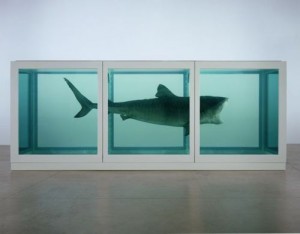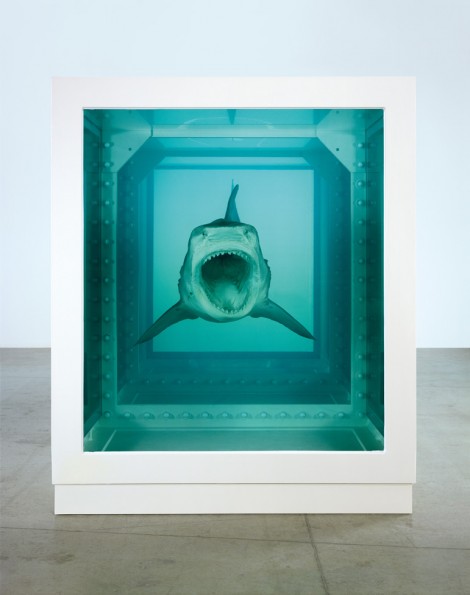Since its initial installation the shark has been replaced with younger models due to inevitable decomposition. This is highly significant; the shark can be seen to be representative of death, and whilst Hirst may have wished to present a moment frozen in time, his shark is still subject to the wearing away and degradation that comes with the passing of time, and its replacements remind us that this is something we are all subject to. The replacement of the shark also highlights how much of Hirst’s work comprises of copying, and mass reproducing. As opposed to more classical notions of what constitutes an ‘artist’, Hirst seems to place little value on originality and authenticity, with the majority of his works being produced by his team of helpers, and not the man himself.
The shark in the tank is completely isolated from its natural setting, instead of being in motion, in the water, we see it completely frozen and preserved. For most, it may be the first time we have come so close to a shark, with many of us only seeing them on television or perhaps at an aquarium. Here we have a direct experience of the shark, not mediated through any media. Thus we are forced to consider the shark in a new and different context and re-evaluate how we perceive the animal. This recontextualisation of the shark is interesting, partly, it is reminiscent of the appropriation of popular culture images by artists such as Warhol, taking banal images and exploring them in a new light. I mean this in relation to the dominant portrayal of the shark in popular culture; that of Jaws. This image of the open jaws of a shark is something most of us are at least familiar with even if we have not seen the film; it evokes unease and fear. In Hirst’s piece, we come face to face with the reality and physicality of this familiar image and are forced to consider it in a new setting.
The shark possesses an uncanny simultaneity; it seems to be both dead and alive at the same time. Obviously it is dead, but its commanding and unnerving presence, and power over the viewer makes it feel as though it could be alive. Its complete stillness gives it an eerie and unsettling quality. This stillness could also be interpreted as a sense of peacefulness; however, the facial expression of the shark pertains to a more troublesome feeling and prevents the viewer from feeling at ease. Its wide open mouth gives it a sense of menace and danger. This plays upon what the audience knows about sharks from popular culture, that they can kill people, and that they are dangerous and threatening. It is clearly a conscious decision on Hirst’s part to use a shark as the embodiment of death, instead of an animal that we would perceive as gentle, or beautiful.
The eyes of the shark exaggerate its unnerving presence – where eyes are usually expressive and convey feeling, the eyes of the shark are lidless and stare interrogatively at the audience. This lack of expression in the eyes prevents the viewer from feeling sympathetic towards the animal, instead, we feel threatened by its blank gaze. The mouth of the shark, wide open, shows us an action paused and frozen in time. This is the pervading feeling upon viewing the shark; the viewer feels as though they are looking at a moment in time which has been stopped and suspended, and then displayed. In this sense, the presentation of the shark is similar to what happens when we take a photograph; capturing and immortalising a moment in time. Eventually photographs fade and it is impossible to truly immortalise a moment. Similarly, the various sharks have decomposed and needed replacement. The display of the shark also explores the tradition of taxidermy and the displaying of animals for public view. We are perhaps used to seeing animals stuffed in cases in museums but the preservation of a huge fish is slightly unusual and so it seems that Hirst is slightly upsetting this tradition.
The presence of the shark is visceral, direct and impossible to ignore. This is primarily due to its size; the shark measures a total of 4.3 metres, which makes it incredibly hard to miss or bypass in a gallery setting. In this sense, its existence is similar to the theme of mortality. The theme of death is something that people may often try to avoid or ignore, but it is such a necessary part of human experience and so inextricably linked to life that it is impossible not to acknowledge it and question it at some point. So, the preserved shark deals explicitly with the ‘impossible’ nature of mortality. It is a theme that we are forced to consider, but such a problematic and difficult thing to fully grasp or understand, however, most importantly, it is inescapable, much like the shark.


Comments are closed.